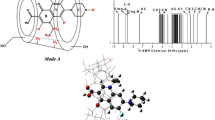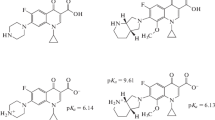Abstract
β-Сyclodextrin (CD) is a perspective class of excipients used in pharmaceutical formulations to enhance solubility, bioavailability, and pharmacokinetics of various poorly soluble drugs, forming a non-covalent guest–host complex. However, the development of such formulations is usually a very laborious and time-consuming process due to lack of appropriate analytical tools to directly track and study the detailed molecular mechanism of such complex formation. Here, using guest–host complexes of fluoroquinolones (FQ) with CDs, as an example, we demonstrate the utility of ATR-FTIR to determine the thermodynamic stability, as well as structural features associated with complex formation, including involvement of certain functional groups. Furthermore, varying the CD’s side groups, we were able to tailor the CD’s geometry and binding surface to make FQ–CD interactions strong enough to potentially affect its pharmacokinetics and justify development of a new sustained-release drug formulation (dissociation constant decreased from 5 * 10−3 M to 10−5 M). 3D molecular modeling with energy optimization supports the findings and conclusions made on the basis of ATR-FTIR data analysis and explains the observed difference in dissociation constants.









Similar content being viewed by others
Abbreviations
- CD:
-
Cyclodextrin
- FQ:
-
Fluoroquinolones
- HPCD:
-
2-Hydroxipropyl-β-cyclodextrin
- LF:
-
Levofloxacin
- MCD:
-
Methyl-β-cyclodextrin
- MF:
-
Moxifloxacin
- SBECD:
-
Sulphobutyl ether β-cyclodextrin
- TB:
-
Tuberculosis
References
Rubinstein E. History of quinolones and their side effects. Chemotherapy. 2001;47(suppl 3):3–8.
Ahmad Z, Pandey R, Sharma S, Khuller GK. Novel chemotherapy for tuberculosis: chemotherapeutic potential of econazole- and moxifloxacin-loaded PLG nanoparticles. Int J Antimicrob Agents. 2008;31(2):142–6.
Zhang J, Ma PX. Cyclodextrin-based supramolecular systems for drug delivery: recent progress and future perspective. Adv Drug Deliv Rev. 2013;65(9):1215–33.
Misiuk W, Jozefowicz M. Study on a host–guest interaction of hydroxypropyl-Β-cyclodextrin with ofloxacin. J Mol Liq. 2015;202:101–6.
Drevenšek P, Košmrlj J, Giester G, Skauge T, Slette E, Sepčić K, et al. X-ray crystallographic, NMR and antimicrobial activity studies of magnesium complexes of fluoroquinolones—racemic ofloxacin and its S-form. Levofloxacin J Inorg Biochem. 2006;100(11):1755–63.
Elbashir AA, Dsugi NFA, Aboul-Enein HY. Supramolecular study on the interaction between ofloxacin and methyl Β-cyclodextrin by fluorescence spectroscopy and its analytical application. J Fluoresc. 2014;24:355–61.
Mamian-Lopez MB, Poppi RJ. Quantification of moxifloxacin in urine using surface-enhanced Raman spectroscopy (SERS) and multivariate curve resolution on a nanostructured gold surface. Anal Bioanal Chem. 2013;405(24):7671–7.
Sousa J, Alves G, Fortuna A, Falcão A. Analytical methods for determination of new fluoroquinolones in biological matrices and pharmaceutical formulations by liquid chromatography: a review. Anal Bioanal Chem. 2012;403(1):93–129.
Deygen IM, Kudryashova EV. New versatile approach for analysis of PEG content in conjugates and complexes with biomacromolecules based on FTIR spectroscopy. Colloids Surf B Biointerfaces. 2016;141:36–43.
Deygen IM, Egorov AM, Kudryashova EV. Structure and stability of Fluoroquinolone-(2-hydroxypropyl)-Β-cyclodextrin complexes as perspective antituberculosis drugs. Mosc Univ Chem Bull. 2016;71(1):1–6.
Kudryashova EV, Deygen IM, Sukhoverkov KV, Filatova LY, Klyachko NL, Vorobei AM, et al. Micronization of levofloxacin by supercritical antisolvent precipitation. Russ J Phys Chem B. 2016;10(4):52–66.
Kudryashova EV, Sukhoverkov KV, Deygen IM, Vorobey AM, Pokrovskiy OI, Parenago OO, et al. Influence of parameters of moxifloxacin micronization by anti-solvent precipitation on its physic-chemical properties. Supercrit Fluids Theory Pract. 2016;11(3):71–85.
Hendy GM, Breslin CB. A spectrophotometric and NMR study on the formation of an inclusion complex between dopamine and a sulphonated cyclodextrin host. J Electroanal Chem. 2011;661(1):179–85.
Gunasekaran S, Rajalakshmi K, Kumaresan S. Vibrational analysis, electronic structure and nonlinear optical properties of levofloxacin by density functional theory. Spectrochim Acta A Mol Biomol Spectrosc. 2013;112:351–63.
Goyne KW, Chorover J, Kubicki JD, Zimmerman AR, Brantley SL. Sorption of the antibiotic ofloxacin to mesoporous and nonporous alumina and silica. J Colloid Interface Sci. 2005;283(1):160–70.
Pandey S, Pandey P, Tiwari G, Tiwari R, Rai AK. FTIR spectroscopy: a tool for quatitative analysis of ciprofloxacin in tablets. Indian J Pharm Sci. 2009;71(4):359–70.
Sahoo S, Chakraborti CK, Mishra SC, Naik S, Nanda UN. FTIR and Raman spectroscopy as a tool for analyzing sustained release hydrogel of ciprofloxacin/carbopol polymer. Int J Pharm Sci Res. 2011;2(2):268–77.
Tomren MA, Másson M, Loftsson T, Tønnesen HH. Studies on curcumin and curcuminoids. XXXI. Symmetric and asymmetric curcuminoids: stability, activity and complexation with cyclodextrin. Int J Pharm. 2007;338(1–2):27–34.
Saenger W. Cyclodextrin inclusion compounds in research and industry. Angew Chem Int Ed Engl. 1980;19(5):344–62.
Stella VJ, He Q. Cyclodextrins. Toxicol Pathol. 2008;36(1):30–42.
Jelić R, Tomović M, Stojanović S, Joksović L, Jakovljević I, Djurdjević P. Study of inclusion complex of β-cyclodextrin and levofloxacin and its effect on the solution equilibria between gadolinium(III) ion and levofloxacin. Monatshefte für Chemie - Chem Mon. 2015;146(10):1621–30.
Dsugi NFA, Elbashir AA. Supramolecular interaction of moxifloxacin and β-cyclodextrin spectroscopic characterization and analytical application. Spectrochim Acta A Mol Biomol Spectrosc. 2016;137:804–9.
Jambhekar SS, Breen P. Cyclodextrins in pharmaceutical formulations II: solubilization, binding constant, and complexation efficiency. Drug Discov Today. 2016;21(2):363–8.
Tóth G, Mohácsi R, Rácz A, Rusu A, Horváth P, Szente L, et al. Equilibrium and structural characterization of ofloxacin–cyclodextrin complexation. J Incl Phenom Macrocycl Chem. 2013;77(1):291–300.
Bandi N, Wei W, Roberts CB, Kotra LP, Kompella UB. Preparation of budesonide– and indomethacin–hydroxypropyl-β-cyclodextrin (HPBCD) complexes using a single-step, organic-solvent-free supercritical fluid process. Eur J Pharm Sci. 2004;23:159–68.
Zu S, Yang L, Huang J, Ma C, Wang W, Zhao C, et al. Micronization of taxifolin by supercritical antisolvent process and evaluation of radical scavenging activity. Int J Mol Sci. 2012;13(7):8869–81.
Acknowledgments
This research is supported by RSF 15-13-00063. The authors thank Dr. Vinogradov A.A. for his comments on an earlier version of the manuscript and fruitful discussions and Dr. Putilin S.N. (Bruker AXS GmbH) for the help in X-ray experiments.
Author information
Authors and Affiliations
Contributions
The manuscript was written through contributions of all authors. All authors have given approval to the final version of the manuscript.
Corresponding author
Ethics declarations
Conflict of interest
The authors declare that they have no conflict of interest.
Electronic supplementary material
ESM 1
(PDF 159 kb)
Rights and permissions
About this article
Cite this article
Le-Deygen, I.M., Skuredina, A.A., Uporov, I.V. et al. Thermodynamics and molecular insight in guest–host complexes of fluoroquinolones with β-cyclodextrin derivatives, as revealed by ATR-FTIR spectroscopy and molecular modeling experiments. Anal Bioanal Chem 409, 6451–6462 (2017). https://doi.org/10.1007/s00216-017-0590-5
Received:
Revised:
Accepted:
Published:
Issue Date:
DOI: https://doi.org/10.1007/s00216-017-0590-5




